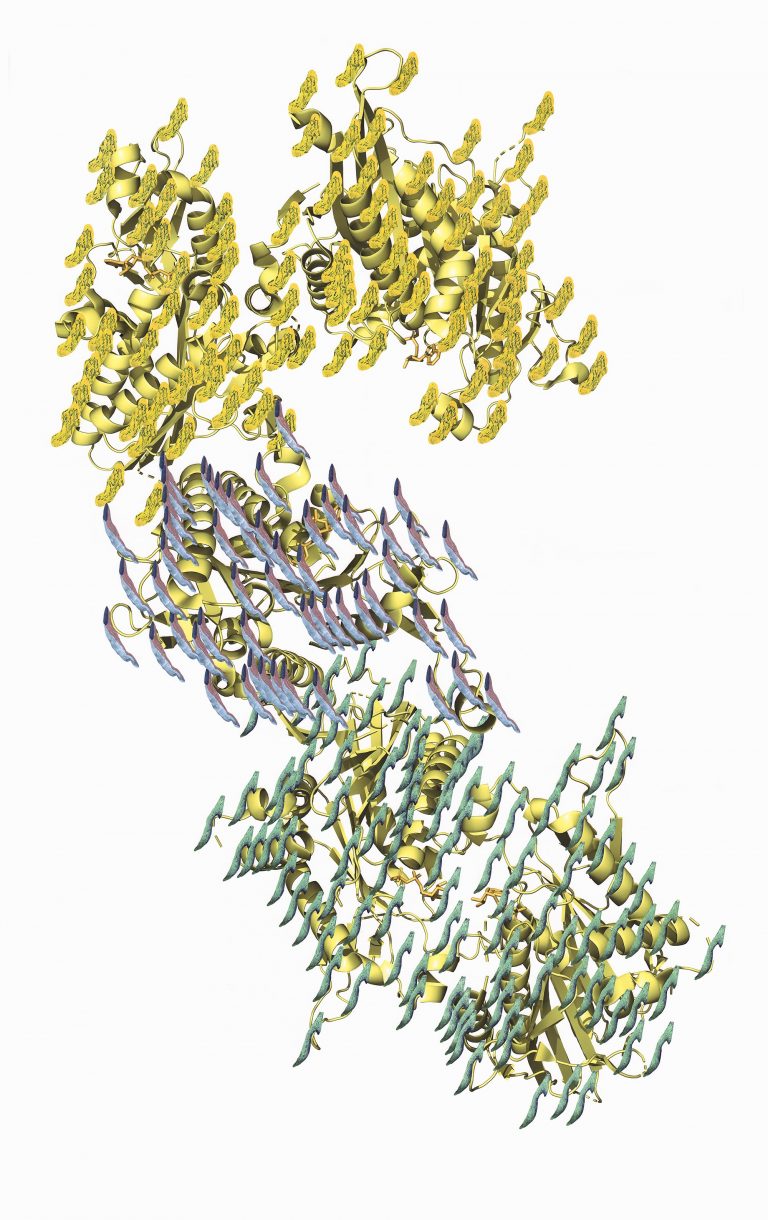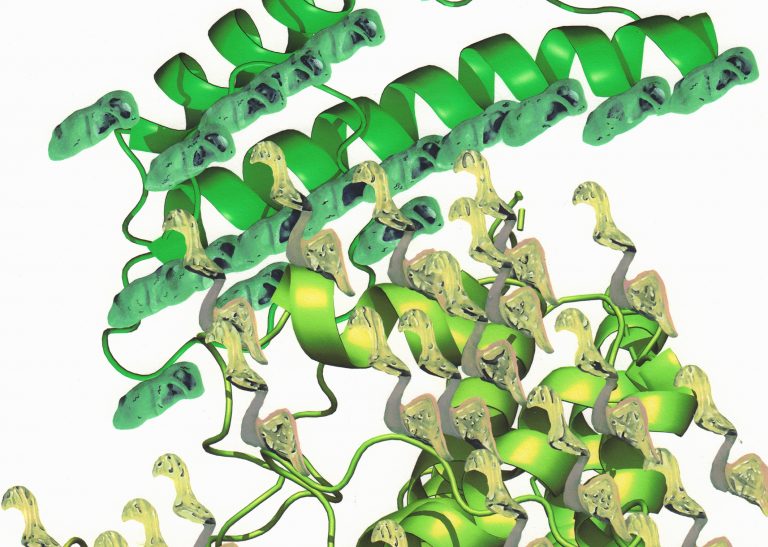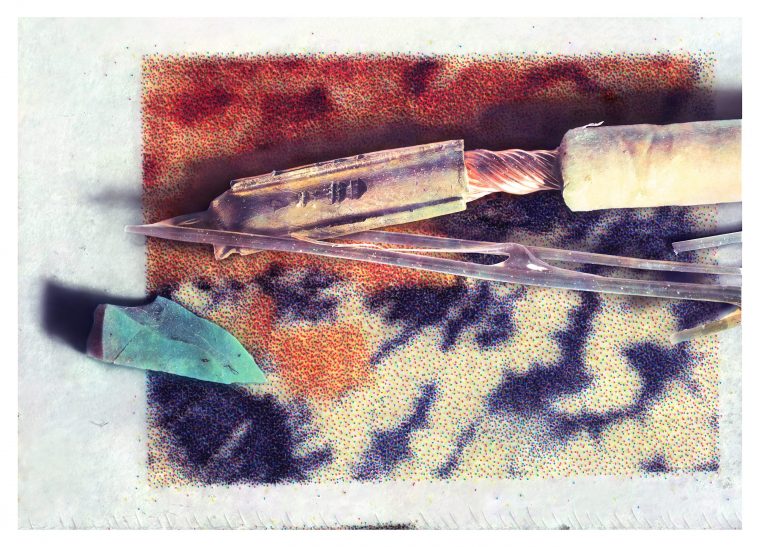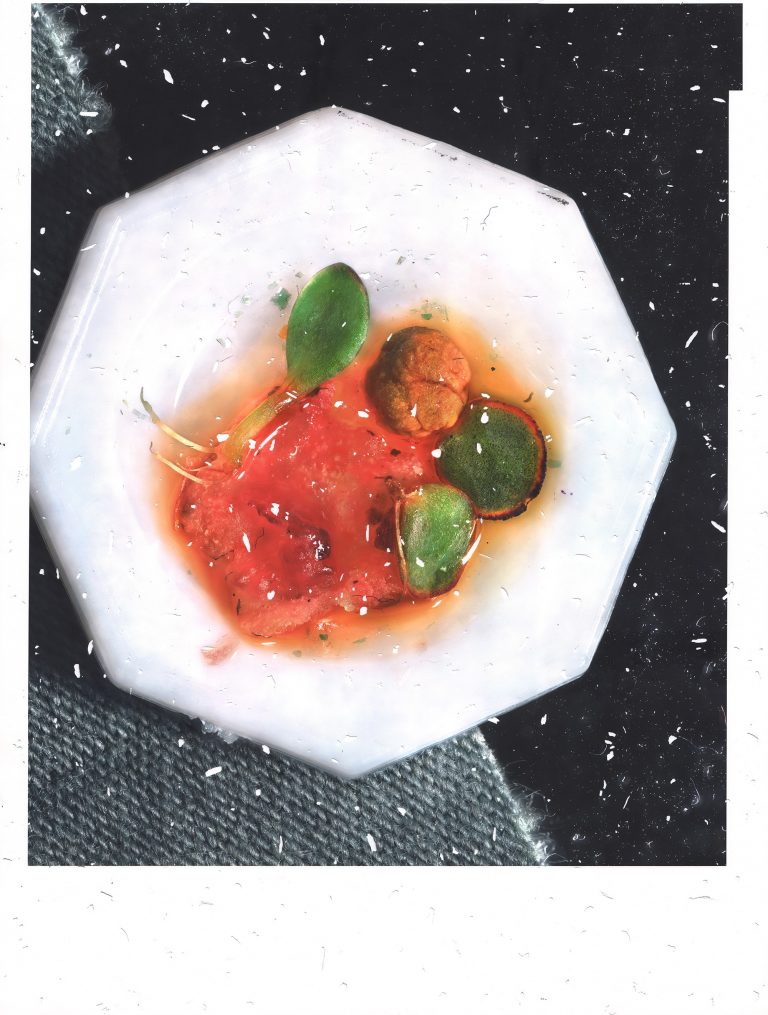Molecules of Vision
Ran Zhang and Mihnea Mircan in conversation
This is an excerpt from the conversation between the artist Ran Zhang (*1981 in Tianjin, China) and the curator Mihnea Mircan (*1976 in Bucharest, Romania). For the complete version of the interview please check the website of Plan B. On the occasion of Gallery Weekend Berlin 2020 the gallery will present Ran Zhangs most recent body of works.
Mihnea Mircan (MM)
I would like to approach your exhibition at Plan B as a question of distance, of the perceptual calibrations you stage, as they are required by the different distances to the visual object. Your interest seems to lie with the place, as much as with the nature of images: ‘where is the picture?’ feels like an adequate segue into a project articulated like a telescope, zooming between different resolutions and proximities, between ways in which particles coalesce into discernible patterns in front of the unaided or microscope-enhanced senses. The selection of works for this exhibition, it seems to me, does justice to the ensemble of your practice, as it reads actual depths through abstract ones.
Ran Zhang (RZ)
The exhibition contains works from two of my most recent projects. Chiral is a body of work that includes inkjet prints with randomly punched holes into them, showing, in microscopic magnification, miniature food settings. Resolution of Traits, the latest project, uses pigment to render the textures of made-up objects, stencils of the molecular structures from a specific protein family. These projects followed similar conceptual routes in their realization: each borrows a subject that seems to me to be in need of an image and visualizes the tangible body of a particular feeling, of something that eludes any particular perceptual modality. In both cases, something clarifies while remaining formless – elucidation remains bound with shapelessness. I was searching for a transitory state of being through visual perception and image making. The works themselves can be seen as the recording of an event that did not take place, perhaps of a moment of looking directly at something that remains very abstract and open.
I have been observing different objects under a microscope for six years. Staring into the lens for hours debilitates my sense of self: I become like a ‘nobody’, shaped more by the structures I observe than by the stable architecture of an ‘I’. Then suddenly I become self-conscious, seeing my own eyelashes projected upside down, or tiny sparkling dots that seem to scratch my eyes (reading about it tells me they are my own white blood cells). I see a phenomenon called ‘floaters’, little worm-like entities floating through my field of vision, which are in fact chains of molecules magnified by my own ocular lenses. I peer into the visual anatomy of my own body. Yet the inside is out, becoming folded with the magnified object that is at the other end of the eyepiece. It scares me that what I am made of is transparent to such extent and so readily assimilated into a larger, nebulous situation, and not within a more secure envelope of individuality. Looking through the microscope, I operate within the sphere of an ‘I’ that shimmers and vibrates biochemically. To see, in this context, literally means I get to observe how my own molecular structures are combined with the objects’ surface features to create a third thing, and try to understand what precisely is being ‘composed’ there. I find myself in a state suspended between knowing and not knowing, forming and con-forming. This state, ‘it’, feels like a non-linear history without anyone specific doing the writing, or the editing of ‘it’. ‘It’ is an amalgam of bio-events and bio-fictions, an interface for intentions and slippages that are emotional and indifferent at the same time.

Ran Zhang, Resolution of Traits 5.1, 2019
Fictional objects wrap around the crystal structures of three human kinesin family members in complex with ADP acrylic, watercolor, ink and pigment on inkjet print
180 x 112 cm
[PDB ID: 3B6U/3NWN/3B6V, Zhu,H., Shen,Y., Tempel, W., Landry, R., Arrowsmith, C.H., Edwards, A.A., Sundstrom, M., Weigelt, J., Bochkarev, A., Park, H. (2007) Motor Domain of Human Kinesin Family Member 3B in Complex with ADP; (2010) crystal structure of the human KIF9 motor domain in complex with ADP; (2007) motor domain of human kinesin family member 3C in complex with ADP]
MM
I am struck by the symmetries that form between the mobility of proteins replenishing and reconstructing the body – a real-abstract landscape of muscular contraction and exertion – and the motion of your own gaze between areas of formlessness, opacity and resemblance. An anonymous body looking for its points of activation, organizing its motile triggers, and you, looking for its shape, modality, image. I think these two dynamics converge in a kind of punctum: maybe an idea of capture, an expanded understanding of one of photography’s original mandates. You capture scenes of capture, or build the possibility of apprehending an image, the conditions under which certain things come temporarily into view and the obligations presupposed by their exposure.
RZ
Over time, the constant observation of microscopic objects changed my visual perception, and the action of seeing turned into a content of sorts, a behavior, or a ritual. I developed an interest in the biochemical force of the body that makes the action of seeing possible, rather than focus on the ‘result’ of seeing. I researched the biological processes that drive seeing. I became especially interested into a family of molecules called motor proteins.
As the motor proteins themselves are too small to be seen with current technology, they can only be depicted through highly suggestive computer visualizations, in which the colours and shapes are used only for communicating purposes and studying functions and responses, rather than observe any preoccupation with resemblance or aesthetical concern. These visualisations are in fact pure information, not images. At the same time it is unavoidable that an image is created as a side effect, which can be read emotionally, aesthetically or psychologically. Any diagram carries its own dynamic, its own imaginative iconography of desires and anxieties. I am interested in the fact that the creation of an image can be a by-product of something else, as I am in the fact that the visual apparatus employed to render the internal workings of image formation in the eye becomes unconditionally effective and strictly utilitarian. In the series Resolution of Traits, I got interested in the molecular reality that cannot be seen but requires visual experience to be understood, and I wanted to make these works in order to find a way to speak about a kind of pre-intention that initiates an obscure connection between the will of creating an image and the macro-organism that operates the image.

Ran Zhang, Resolution of Traits 3.1, 2019
Fictional objects wrap around the crystal structure of full length human cytoplasmic dynein acrylic, watercolor, ink and pigment on inkjet print
170 x 112 cm
(detail)
[PDB ID: 5NVU, H.E., Rondelet, A., Lacey, S.E., Bahi-Buisson, N., Bird, A.W., Carter, A.P. (2017) Cryo-EM reveals how human cytoplasmic dynein is auto-inhibited and activated]
Perhaps, like you said, capturing scenes of capture, or perhaps there is nothing to ‘capture’, because the morph replaces cause and effect, and turns linearity into a palpable volume. Instead of entertaining such a thought as an engine for making images, it is holding onto images that creates such a thought for me, repeatedly and progressively. Progressively, but not in the sense of achieving a goal. Something like this: how can something be in progress without moving on at all? This, for me, is what the image is, nakedly. I don’t think the relation between us, the image and the outside world has changed substantially since the first human being made a picture, and this fascinates me, that the élan that pre-formats and effects a cut in reality never changes. The drive, the making, and the image become a set, instead of being a process leading from the trigger to what is being triggered. Regardless of time and space, within this set, the chemically folded motor proteins, the body and its reflexes and the pictured picture all have their unique qualities, but by translating them into acts of thinking and sensing, their qualities disappear. Then they reappear, independently, and side by side in our mind. They become something else simultaneously, but strangely all the same. The calcium-signaling myosin proteins dispatch contractions to each silky muscle fiber in the hand. The hand alters a desired surface with pigments, their superficial microplastic threads and alien organisms are pressed into each other, crushed and disappeared into the intended meaning of a newborn image. For the mind, any of these moments is an equivalent occurence, punctuations over the course of event. I am not saying that the mind’s participation to this event is entirely mechanical, there is something warm and affecting about it. I am trying to illuminate the thresholds at which these kinds of activities and volitions are pitted against one another.
MM
Your analysis of units and voids, of the movements by which units create wholes and circulate the voids between those wholes, reminds me of what atomist philosophers were saying about perception. For someone like Democritus, the world is made of atoms, literally ‘uncuttable’ particles, that are both physically and theoretically indivisible. They form the cosmos by whirling motions where they strike against one another, rebound and interlock. But the soul too is made of atoms, rounder and finer than others, capable of rapid movement into all parts of the body. Upon arrival at their destination, they encounter the material traces of objects viewed or touched, the remnants of perceived sounds: atomist vision was made possible not by light being reflected from the surfaces of things, but because things humans looked at were perpetually shedding peelings of their outer surfaces. These fleeces of appearance, entering directly into the eye – fragments of the object ingested in an ocular metabolism – were what the eye actually saw. I think those infinitesimal fractions, floating from the skins of observed things, do both material and metaphorical work in your practice.
RZ
I have always been interested in experiencing different scales. In 2012, I bought a proper microscope to look beyond the compact and opaque textures that I could paint. I wouldn’t say I opened a Pandora box for myself, it was actually a liberating experience. I freed myself from the notion of physicality and abstraction. Whether image, space, scale, texture, physicality and abstraction are the same or not, my interest was set for the possibility of seeing: the fact of being able to see, the action of seeing, and the consequences of seeing. I totally get atomism. The single-brush-hair structure of the textures I paint possesses different surface features when it enters the eyes. The texture can be seen not because of the lattice structure occupied by the molecules of which the paint is composed, but because of experiencing the global property of light being reflected from the textural surface, and by knowing the global property that can be causally explained by the behaviour of elements at the subatomic level. There is a chain-connection from the micro to the macro that glues the components of reality together as a whole, but the possibility of seeing perpetually dissects this reality.
MM
I’d like to talk about the squinting reality of other objects that appear in your work, suspended between scales, or existing within a kind of scalar illusionism, a trompe l’oeil. I wonder about their function as narrative triggers, as actants within the different uses of your method that each project articulates. Reading your thoughts thus far, it has been a joy to discover the extent to which those dimly seen or reconstructed objects carry affect, work as building blocks for an overall narrative that animates your practice.
RZ
Up to Resolution of Traits, I only worked with objects and instruments that I could operate with my own hands. I would say my previous works were associated with evidence, direct experience of physicality and what-it’s-like-ness, rather than pondering a subject or a set of theoretical arguments. From a dust-ball to a pinhead, the more insignificant a familiar object can be, the more complex, and stranger, it appears in a particular scale. An octahedrite meteorite 400 times magnified appears to have the sandy texture of a flattened sand dune in a construction site on a sunny day. The question that arises from its intriguing pattern disappears when the pattern is magnified, vanished in front of the gaze. A 400 times magnified sugar crumb preserves its structural manifestation, and the strangeness arises only from the realization of the change of scale. Such an acknowledgement is immaterial, but it glues the materiality together with the same force as nanoparticles filling up the pores of a limestone, to a degree that they become practically identical during the action of seeing. Familiarity seems to be the essential safe zone for one to exist and function, but it feels more like an addiction. An addiction that does not attempt to sate a craving, but indefinitely prolongs the end point of familiarity. It is a paralyzed, anti-spectacular horror, quietly hopping in a swirling motion of the eyes.

Ran Zhang, Natritine Gaze 2 (part 7), 2016
Inkjet print, 4 color silkscreen print, acrylic, watercolor, pigment and ink on paper
100 x 87cm
Then, there is the image enmeshed in the story of scale, object and the observer. In Chiral, the microscopically magnified miniature food settings, that imitate photographic tricks in food advertisement, address how we exploit images to create and design desire, a desire that also leads to us desiring those images in themselves. The works possess two opposite qualities: the invitation of desire, and at the same time the discovery of ‘matter in the wrong place’, which might be another conduit to something like ‘horror’. The magnification not only enlarges the objects, but also unwanted elements and hidden interstices, like dust and microplastics, prompting an uncanny feeling. Thinking about them however, the revealed details are not actually scary, nor is the surplus of reality: they are in fact the reality, excessive as it is. Therefore, the works highlight how the action of desiring something familiar turns desire itself into satiation, while, at the same time, the encounter of strangeness turns the by-product of that desire into horror. Between the desired and the by-product of desire, the random punctures on the inkjet prints force these trajectories together. I am fascinated by the fact that content is not just a narrative, but also a specific way to render details, to place emphases. In this sense, the details become a language to construct meaning that is both objective and subjective.

Ran Zhan, Chiral (1), 2017-18
Punched holes on inkjet print of 100 times magnified miniature food setting
120 x 91 cm
Similarly to Resolution of Traits, the fictional objects were created by using digitally distorted snapshots of daily objects that are related to the body, such as clothes, food, tableware, furniture, personal objects, etc. They are fictional because they are mock-ups based on a subjective choice, as opposed to the purported collective objectivity that goes into the making of scientific visualization. Then I used paint to alter the superficial textures of those fictional objects. They seem to be identical, but each is uniquely resembling to another. Content and detail carve a space for themselves into the eyes, as immaterial passages and physical units are stirred into thin films of pigment jellies, and objects expand into an infinite otherness. The strangeness, the horror has been tamed by the handwork, which aggregates its paced dip-and-paint traces – a vanished warmth – onto the mechanically printed underlayer, creating a tension between intelligence (the human touch) and ‘extelligence’ (the collective knowledge and technologies that exist outside of our bodies). The action of painting and the painted objects find themselves attached, afloat towards some form of self-evidence. A notion of the body spins out from all constituents of the works: look, look, look, one’s ciliary muscles and optical nerves self-fulfil spiralling, curving traits.
